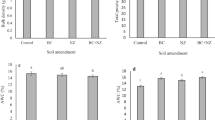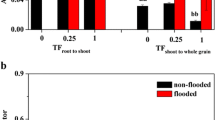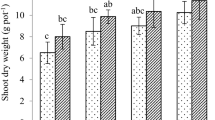Abstract
Zeolite is one of the potential passivating amendments for the immobilization of lead (Pb) in contaminated farmland soils. In this study, pot experiments were carried out to investigate the effects and the mechanisms of zeolite on Pb accumulation in two rice cultivars grown in a slightly Pb-contaminated soil. Results showed that Pb content in grains of Zheyou 18 (ZY-18) decreased by the addition of 6 g zeolite kg−1 soil (E6), which can be attributed to the reduction in soil Pb availability, dissolved organic carbon (DOC), water-soluble iron (Fe) and manganese (Mn), and the transfer factor from soil to grain (TFsoil-grain). These reductions were mainly resulting from the significant increase in soil pH, glutathione (GSH), phytochelatins (PCs), and non-protein (NPT) content in rice root, and the decrease in soil redox potential (Eh), due to zeolite addition. Pb content in brown rice of DL-5 was not significantly affected with E6 treatment, whereas it was raised by applying 12 g zeolite kg−1 soil (E12). The increase of Pb content of Donglian 5 (DL-5) grains with E12 treatment can be attributed to more Pb uptake by the root, higher Pb transfer factors (TFs) between various parts of rice, and significant decrease in GSH, PCs, and NPT contents in the root. It is concluded that a suitable rate of zeolite addition can immobilize Pb in slightly Pb-contaminated acidic soil. However, the final immobilization effect also depends on rice cultivars.





Similar content being viewed by others
Data availability
Not applicable.
References
Ashraf U, Kanu AS, Mo Z, Hussain S, Anjum SA, Khan I, Abbas RN, Tang X (2015) Lead toxicity in rice: effects, mechanisms, and mitigation strategies—a mini review. Environ Sci Pollut Res Int 22(23):18318
Aziz T, Ahmad B, Ashraf M, Arifeen M, Nawab S, Nabi G (2015) A mini review on lead (Pb) toxicity in plants. J Biol Life Sci 6(2):91–01
Baile P, Fernandez E, Vidal L, Canals A (2019) Zeolites and zeolite-based materials in extraction and microextraction techniques. Analyst 144(2):366–387
Barman F, Majumdar S, Arzoo SH, Kundu R (2020) Genotypic variation among 20 rice cultivars/landraces in response to cadmium stress grown locally in West Bengal, India. Plant Physiol Biochem 148:193–206
Bashir S, Zhu J, Fu Q, Hu H (2018) Cadmium mobility, uptake and anti-oxidative response of water spinach (Ipomoea aquatic) under rice straw biochar, zeolite and rock phosphate as amendments. Chemosphere 194:579–587
Bian R, Li L, Bao D, Zheng J, Zhang X, Zheng J, Liu X, Cheng K, Pan G-X (2016) Cd immobilization in a contaminated rice paddy by inorganic stabilizers of calcium hydroxide and silicon slag and by organic stabilizer of biochar. Environ Sci Pollut Res 23(10):10028–100316
Castaldi P, Santona L, Melis P (2005) Heavy metal immobilization by chemical amendments in a polluted soil and influence on white lupin growth. Chemosphere 60(3):365–371
Fang H, Huang L, Wang J, He G, Reible D (2016) Environmental assessment of heavy metal transport and transformation in the Hangzhou Bay, China. J Hazard Mater 302:447–457
Fang Y, Deng X, Lu X, Zheng J, Jiang H, Rao Y, Zeng D, Hu J, Zhang X, Xue D (2019) Differential phosphoproteome study of the response to cadmium stress in rice. Ecotoxicol Environ Saf 180:780–788
Fu J, Zhou Q, Liu J, Liu W, Wang T, Zhang Q, Jiang G (2008) High levels of heavy metals in rice (Oryza sativa L.) from a typical E-waste recycling area in southeast China and its potential risk to human health. Chemosphere 71:1269–1275
Garcia-Carmona M, Romero-Freire A, Aragon MS, Garzon FJM, Peinado FJM (2017) Evaluation of remediation techniques in soils affected by residual contamination with heavy metals and arsenic. J Environ Manag 191:228–236
Geng CN, Zhu YG, Liu WJ, Smith SE (2005) Arsenate uptake and translocation in seedlings of two genotypes of rice is affected by external phosphate concentrations. Aquat Bot 83(4):321–331
Guo J, Li Y, Hu C, Zhou S, Xu H, Zhang Q, Wang G (2018) Ca-containing amendments to reduce the absorption and translocation of Pb in rice plants. Sci Total Environ 637–638:971–979
Guo J, Xie S, Huang Y, Chen M, Wang G (2021) Effects and mechanisms of Cd remediation with zeolite in brown rice (Oryza sativa). Ecotoxicol Environ Saf 226:112813
He KP, Zhang LJ, Shi CM, Zhu XW, Wang KY (2013) Assessment of lead contamination and exposure of residents and crops in traditional artisanal zinc smelting areas. J Occup Environ Med 34(4):263–267
Huang S, Li Q, Yang Y, Yuan C, Ouyang K, You P (2017) Risk assessment of heavy metals in soils of a lead-zinc mining area in Hunan Province (China). J Chem Chem Eng 66:173–178
Khaliq MA, James B, Chen YH, Saqib HSA, Li HH, Jayasuriya P, Guo W (2019) Uptake, translocation, and accumulation of Cd and its interaction with mineral nutrients (Fe, Zn, Ni, Ca, Mg) in upland rice. Chemosphere 215:916–924
Koptsik GN (2014) Modern approaches to remediation of heavy metal polluted soils: a review. Eurasian Soil Science 47(7):707–722
Lai Y-C, Syu C-H, Wang P-J, Lee D-Y, Fan C, Juang K-W (2018) Field experiment for determining lead accumulation in rice grains of different genotypes and correlation with iron oxides deposited on rhizosphere soil. Sci Total Environ 610:845–853
Lee D-S, Lim S-S, Park H-J, Yang HI, Park S-I, Kwak J-H, Choi W-J (2019) Fly ash and zeolite decrease metal uptake but do not improve rice growth in paddy soils contaminated with Cu and Zn. Environ Int 129:551–564
Li J, Li Y, Meng Q (2010) Removal of nitrate by zero-valent iron and pillared bentonite. J Hazard Mater 174(1):188–193
Liang T, Ding H, Wang G, Kang J, Pang H, Lv J (2016) Sulfur decreases cadmium translocation and enhances cadmium tolerance by promoting sulfur assimilation and glutathione metabolism in Brassica chinensis L. Ecotoxicol Environ Saf 124:129–137
Liang X, Han J, Xu Y, Sun Y, Wang L, Tan X (2014) In situ field-scale remediation of Cd polluted paddy soil using sepiolite and palygorskite. Geoderma 235–236:9–18
Liu J, Luo L (2019) Uptake and transport of Pb across the iron plaque of waterlogged dropwort (Oenanthe javanica DC.) based on micro-XRF and XANES. Plant and Soil 441(1):191–205
Liu J, Min Q, Guoliang C, Jianchang Y, Zhu Q (2007) Uptake and translocation of Cd in different rice cultivars and the relation with Cd accumulation in rice grain. J Hazard Mater 143(1–2):443–447
Liu J, Wang D, Song B, Chen Z, Zhang X, Tang Y-T (2019) Source apportionment of Pb in a rice-soil system using field monitoring and isotope composition analysis. J Geochem Explor 204:83–89
Madejón E, Peréz de Mora A, Felipe E, Burgos P, Cabrera F (2006) Soil amendments reduce trace element solubility in a contaminated soil and allow regrowth of natural vegetation. Environ Pollut 139(1):40–52
Mahar A, Wang P, Ali A, Lahori AH, Awasthi MK, Wang Z, Guo Z, Wang Q, Feng S, Li R, Zhang Z (2018) (Im)mobilization of soil heavy metals using CaO, FA, sulfur, and Na2S: a 1-year incubation study. Int J Environ Sci Technol 15(3):607–620
Montenegro A (2015) Copper speciation in soil: time evolution and effect of clay amendment. Water Air Soil Pollut Focus 226:293
Mukwaturi M, Lin C (2015) Mobilization of heavy metals from urban contaminated soils under water inundation conditions. J Hazard Mater 285:445–452
Pan Y, Bonten LTC, Koopmans GF, Song J, Luo Y, Temminghoff EJM, Comans RNJ (2016) Solubility of trace metals in two contaminated paddy soils exposed to alternating flooding and drainage. Geoderma 261:59–69
Park S-J, Kang K, Lee C-G, Choi J-W (2019) Remediation of metal-contaminated marine sediments using active capping with limestone, steel slag, and activated carbon: a laboratory experiment. Environ Technol 40(26):3479–3491
Pedron F, Petruzzelli G, Barbafieri M, Tassi E (2009) Strategies to use phytoextraction in very acidic soil contaminated by heavy metals. Chemosphere 75:808–814
Radziemska M, Wyszkowski M, Bęś A, Mazur Z, Jeznach J, Brtnický M (2019) The applicability of compost, zeolite and calcium oxide in assisted remediation of acidic soil contaminated with Cr(III) and Cr(VI). Environ Sci Pollut Res 26(21):21351–21362
Rama S, Devi MN, Prasad V (1998) Copper toxicity in Ceratophyllum demersum L (Coontail), a free floating macrophyte: response of antioxidant enzymes and antioxidants. Plant Sci 138(2):157–165
Sheikhhosseini A, Shirvani M, Shariatmadari H (2013) Competitive sorption of nickel, cadmium, zinc and copper on palygorskite and sepiolite silicate clay minerals. Geoderma 192:249–253
Sokolova T (2020) Low-molecular-weight organic acids in soils: sources, composition, concentrations, and functions: a review. Eurasian Soil Sci 53:580–594
Song Y, Wang Y, Mao W, Sui H, Yong L, Yang D, Jiang D, Zhang L, Gong Y (2017) Dietary cadmium exposure assessment among the Chinese population. PLoS One 12(5):e0177978. https://doi.org/10.1371/journal.pone.0177978
Sun L, Chen S, Chao L, Sun T (2007) Effects of flooding on changes in Eh, pH and speciation of cadmium and lead in contaminated soil. Bull Environ Contam Toxicol 79:514–518
Sun Y, Xu Y, Xu Y, Wang L, Liang X, Li Y (2016) Reliability and stability of immobilization remediation of Cd polluted soils using sepiolite under pot and field trials. Environ Pollut 208:739–746
Tahervand S, Jalali M (2017) Sorption and desorption of potentially toxic metals (Cd, Cu, Ni and Zn) by soil amended with bentonite, calcite and zeolite as a function of pH. J Geochem Explor 181:148–159
Tripathi D, Tripathi P, Dwivedi S, Kumar A, Mishra A, Chauhan P, Norton G, Nautiyal C (2014) Roles for root iron plaque in sequestration and uptake of heavy metals and metalloids in aquatic and wetland plants. Metallomics 6(10):1789–1800
Uchimiya M, Bannon DI (2013) Solubility of lead and copper in biochar-amended small arms range soils: influence of soil organic carbon and pH. J Agric Food Chem 61(32):7679–7688. https://doi.org/10.1021/jf401481x
Vrinceanu NO, Motelica DM, Dumitru M, Calciu I, Tanase V, Preda M (2019) Assessment of using bentonite, dolomite, natural zeolite and manure for the immobilization of heavy metals in a contaminated soil: the Copsa Mica case study (Romania). CATENA 176:336–342
VukojevicMedvidovic N, Nuic I, Ugrina M, Trgo M (2018) Evaluation of natural zeolite as a material for permeable reactive barrier for remediation of zinc-contaminated groundwater based on column study. Water Air Soil Pollut 229(11):14
Wang MY, Chen AK, Wong MH, Qiu RL, Cheng H, Ye ZH (2011) Cadmium accumulation in and tolerance of rice (Oryza sativa L) varieties with different rates of radial oxygen loss. Environ Pollut 159(6):1730–1736
Wong SC, Li XD, Zhang G, Qi SH, Min YS (2002) Heavy metals in agricultural soils of the Pearl River Delta South China. Environ Pollut 119(1):33–44
Xu Y, Xu Y, Wang P, Wang L, Sun Y, Huang Q, Huang R (2016) Two-year stability of immobilization effect of sepiolite on Cd contaminants in paddy soil. Environ Sci Pollut Res 23(13):12922–12931
Zhang C, Yin X, Gao K, Ge Y, Cheng W (2013) Non-protein thiols and glutathione S-transferase alleviate Cd stress and reduce root-to-shoot translocation of Cd in rice. J Plant Nutr Soil Sci 176(4):626–633
Zhang X, Zhong T, Liu L, Ouyang X (2015) Impact of soil heavy metal pollution on food safety in China. PLoS ONE 10:e0135182
Zhao FJ, Hamon RE, Lombi E, McLaughlin MJ, McGrath SP (2002) Characteristics of cadmium uptake in two contrasting ecotypes of the hyperaccumulator Thlaspi caerulescens. J Exp Bot 53(368):535–543
Zheng H, Wang M, Chen S, Li S, Lei X (2019) Sulfur application modifies cadmium availability and transfer in the soil-rice system under unstable pe+pH conditions. Ecotoxicol Environ Saf 184:109641
Zorpas AA, Inglezakis VJ, Loizidou M (2007) Heavy metals fractionation before, during and after composting of sewage sludge with natural zeolite. Waste Manag 28(11):2054–2060. https://doi.org/10.1016/j.wasman.2007.09.006
Zulfiqar U, Farooq M, Hussain S, Maqsood M, Hussain M, Ishfaq M, Ahmad M, Anjum MZ (2019) Lead toxicity in plants: impacts and remediation. J Environ Manag 250:109557
Acknowledgements
The authors are thankful to Huang Bifei for their technical assistance in the use of the Lab instruments. The μ-XRF beam time was granted by the 4W1B beamline of the Beijing Synchrotron Radiation Facility, Institute of High Energy Physics, Chinese Academy of Sciences. The staff members of 4W1B are acknowledged for their support in measurements and data reduction.
Funding
This work was supported by the National Natural Science Foundation of China (Grant No. U1305232).
Author information
Authors and Affiliations
Contributions
All authors contributed to the study conception and design. Material preparation, data collection, and analysis were performed by JG, MC, YH, SX, CH, BX, and GW. The first draft of the manuscript was written by JG, and all authors commented on the previous version of the manuscript. All authors read and approved the final manuscript.
Corresponding author
Ethics declarations
Ethics approval and consent to participate
Not applicable.
Consent for publication
Not applicable.
Competing interests
The authors declare no competing interests.
Additional information
Responsible Editor: Gangrong Shi
Publisher's note
Springer Nature remains neutral with regard to jurisdictional claims in published maps and institutional affiliations.
Supplementary Information
Below is the link to the electronic supplementary material.
Rights and permissions
About this article
Cite this article
Guo, J., Chen, M., Huang, Y. et al. Understanding the mechanisms of zeolite in inhibiting Pb accumulation in different rice cultivars (Oryza sativa). Environ Sci Pollut Res 29, 80312–80322 (2022). https://doi.org/10.1007/s11356-022-21331-6
Received:
Accepted:
Published:
Issue Date:
DOI: https://doi.org/10.1007/s11356-022-21331-6




